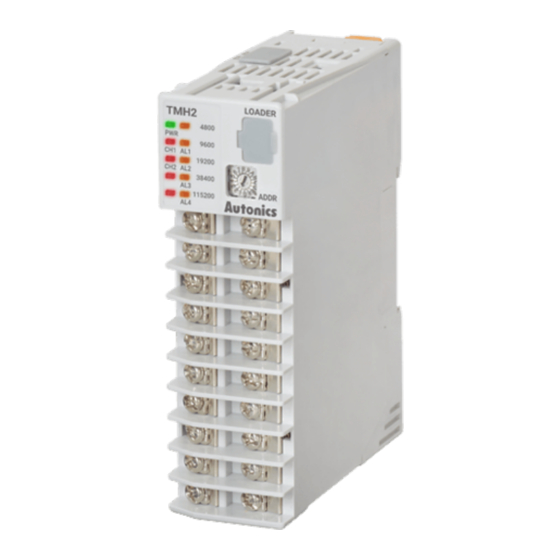Autonics TMH Series Panduan Memulai Cepat
Jelajahi secara online atau unduh pdf Panduan Memulai Cepat untuk Pengontrol Suhu Autonics TMH Series. Autonics TMH Series 6 halaman. Modular2/4-channel pid temperature controllers with screw connector

TCD210177AA
Modular 2/4-Channel PID
Temperature Controllers
with Screw Connector
TMH Series
For your safety, read and follow the considerations written in the instruction
manual, other manuals and Autonics website.
The specifications, dimensions, etc are subject to change without notice for product
improvement Some models may be discontinued without notice.
Features
[Common]
• Easy maintenance with detachable body and base terminal
• Power supply and communication with expansion connectors (up to 32 units)
[TMH2/4 Series (Control Module) ]
• Multi-channel (2-channel/4-channel) input and output control: Expandable up to 32
units (64-channels/128-channels)
• 50 ms high-speed sampling rate and ±0.3% measurement accuracy
• Simultaneous heating and cooling control function and auto/manual control mode
(patent: Korea Patent Registration 10-1624105)
[TMHA (Analog Input / Output Option Module) ]
• 4 channels, various input types/temperature ranges/transmission outputs
• 50 ms high-speed sampling rate and ±0.3% measurement accuracy
[TMHE (Digital Input / Alarm Output Option Module) ]
• 8 digital inputs / 8 alarm outputs
[TMHCT (CT Input Option Module) ]
• 8 CT inputs
[TMHC (Communication Modules) ]
• Allows connection of control modules and option modules to master devices
• Connect up to 32 control/option modules per communication model
ᜣ ᜧ ᜢ ᜫ
Safety Considerations
• Observe all 'Safety Considerations' for safe and proper operation to avoid hazards.
• symbol indicates caution due to special circumstances in which hazards may occur.
Warning
Failure to follow instructions may result in serious injury or death
01. Fail-safe device must be installed when using the unit with machinery that
may cause serious injury or substantial economic loss. (e.g. nuclear power
control, medical equipment, ships, vehicles, railways, aircraft, combustion
apparatus, safety equipment, crime/disaster prevention devices, etc.)
Failure to follow this instruction may result in personal injury, economic loss or fire.
02. Do not use the unit in the place where flammable/explosive/corrosive gas,
humidity, direct sunlight, radiant heat, vibration, impact, or salinity may be
present.
Failure to follow this instruction may result in explosion or fire.
03. Install on a device panel to use.
Failure to follow this instruction may result in fire.
04. Do not connect, repair, or inspect the unit while connected to a power
source.
Failure to follow this instruction may result in fire.
05. Check 'Connections' before wiring.
Failure to follow this instruction may result in fire.
06. Do not disassemble or modify the unit.
Failure to follow this instruction may result in fire.
Caution
Failure to follow instructions may result in injury or product damage
01. When connecting the power input and relay output, use AWG 20 (0.50 mm
cable or over and tighten the terminal screw with a tightening torque of 0.74
to 0.90 N·m.
When connecting the sensor input and communication cable without
dedicated cable, use AWG 28 to 16 cable and tighten the terminal screw with
a tightening torque of 0.74 to 0.90 N·m.
Failure to follow this instruction may result in fire or malfunction due to contact
failure.
02. Use the unit within the rated specifications.
Failure to follow this instruction may result in fire or product damage
03. Use a dry cloth to clean the unit, and do not use water or organic solvent.
Failure to follow this instruction may result in fire or electric shock.
04. Keep the product away from metal chip, dust, and wire residue which flow
into the unit.
Failure to follow this instruction may result in fire or product damage.
Cautions during Use
• Follow instructions in 'Cautions during Use'. Otherwise, it may cause unexpected
accidents.
• Check the polarity of the terminals before wiring the temperature sensor.
For RTD temperature sensor, wire it as 3-wire type, using cables in same thickness and
length.
For thermocouple (CT) temperature sensor, use the designated compensation wire for
extending wire.
• The connection of this unit should be separated from the power line and high voltage
line in order to prevent inductive noise.
In case of installing power line and input signal line closely, use line filter or varistor at
power line and shielded wire at input signal line.
The connection of this unit should be separated from the power line and high voltage
line in order to prevent inductive noise.
)
2
